Abstract
Midazolam is a new water-soluble benzodiazepine with a much shorter pharmacologic half-life than diazepam. Despite this shorter pharmacologic half-life, several reports indicate that patients do not recover more rapidly after sedation with midazolam than with diazepam. The purpose of this study was to compare recovery of patients sedated with either midazolam or diazepam alone or in combination with fentanyl using the digit symbol substitution test (DSST) and Trieger test. Patients were randomly divided into treatment groups and recovery tests were administered to the patients prior to sedation and at 60, 120, and 180 minutes after achieving a standardized sedative endpoint. Patients who received midazolam alone had significantly fewer numbers of correct reponses on the DSST than patients who received midazolam plus fentanyl or diazepam with or without fentanyl. When midazolam was combined with fentanyl there was no significant difference between results obtained on the DSST when compared with either diazepam group. Comparisons between all groups using dots missed or millimeter deviation on the Trieger test showed no statistical difference between any groups. These data indicate that midazolam as a single IV agent has a slightly prolonged recovery phase compared to diazepam. The addition of fentanyl to the sedation regimen allows reduction in the midazolam dose resulting in a recovery time comparable to that of diazepam.
Full text
PDF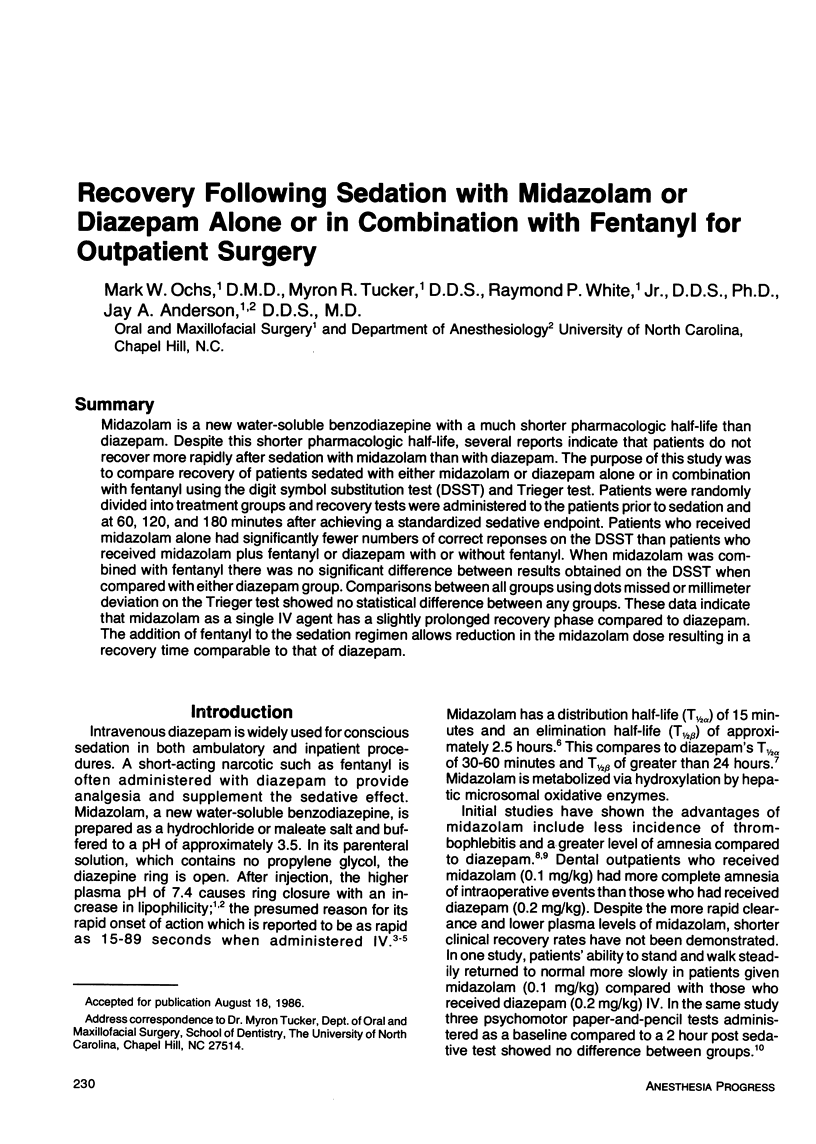
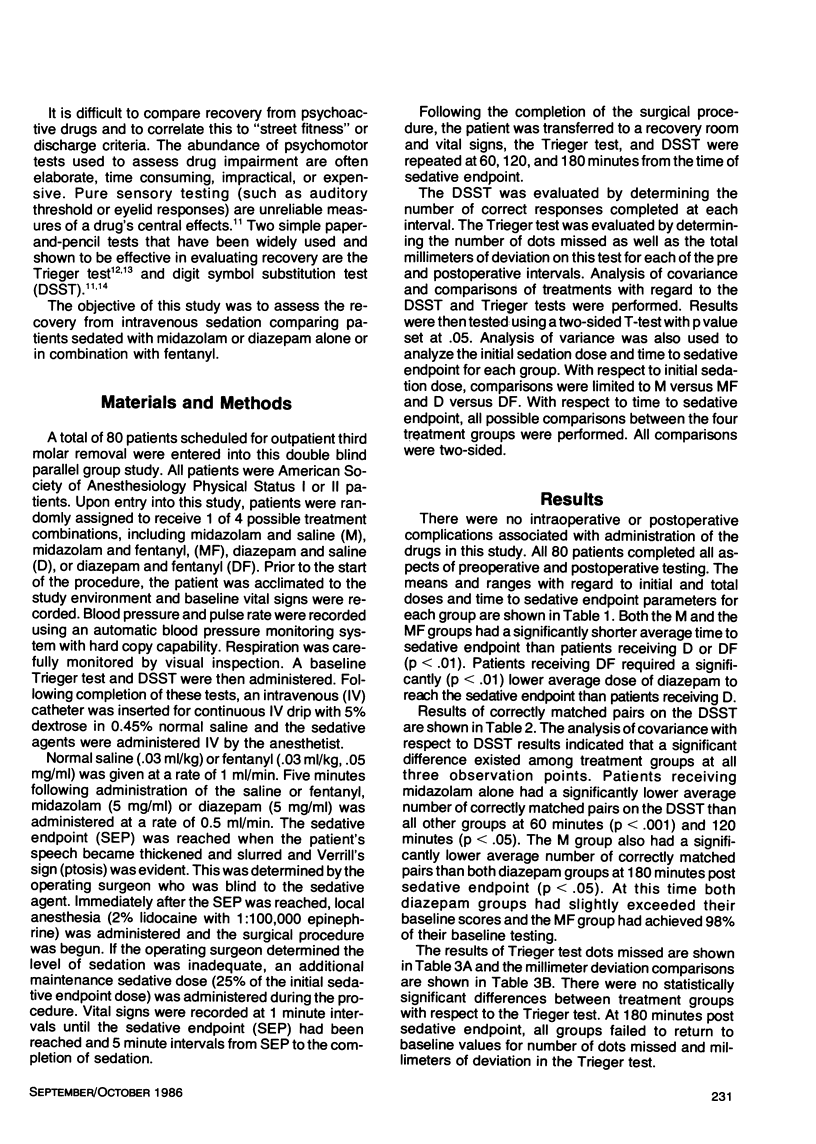
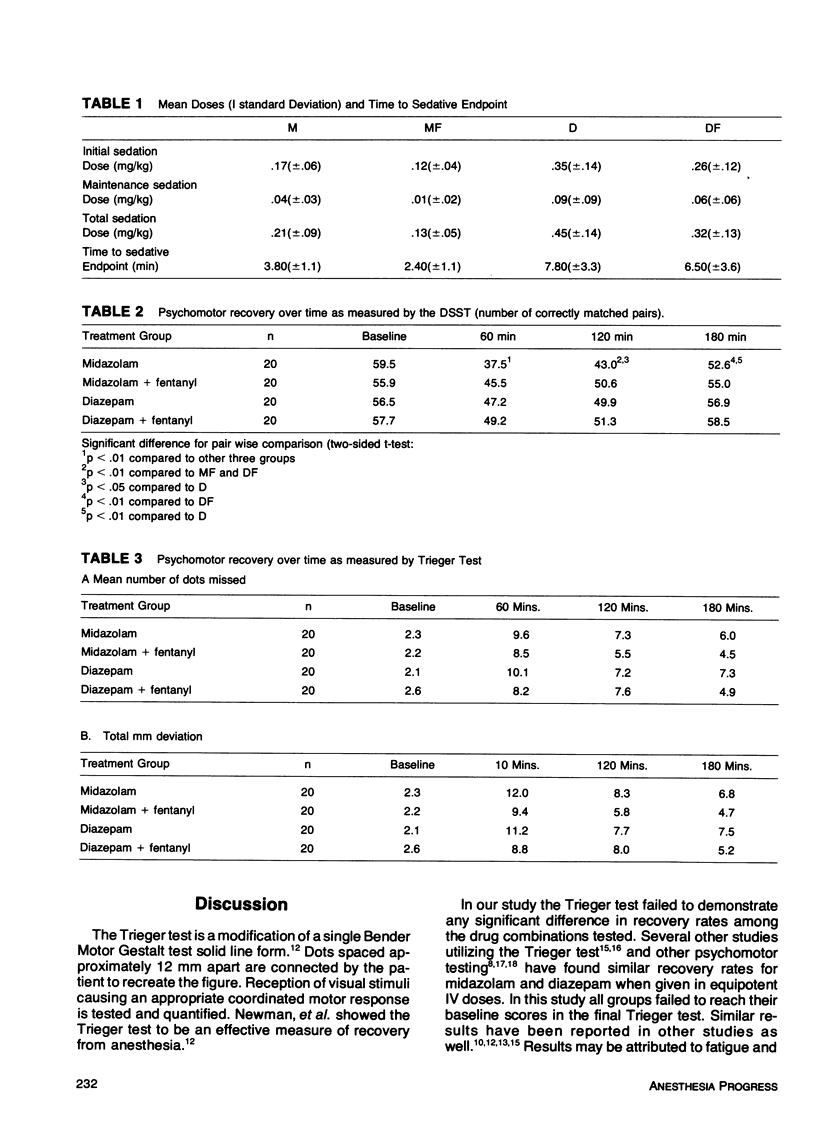
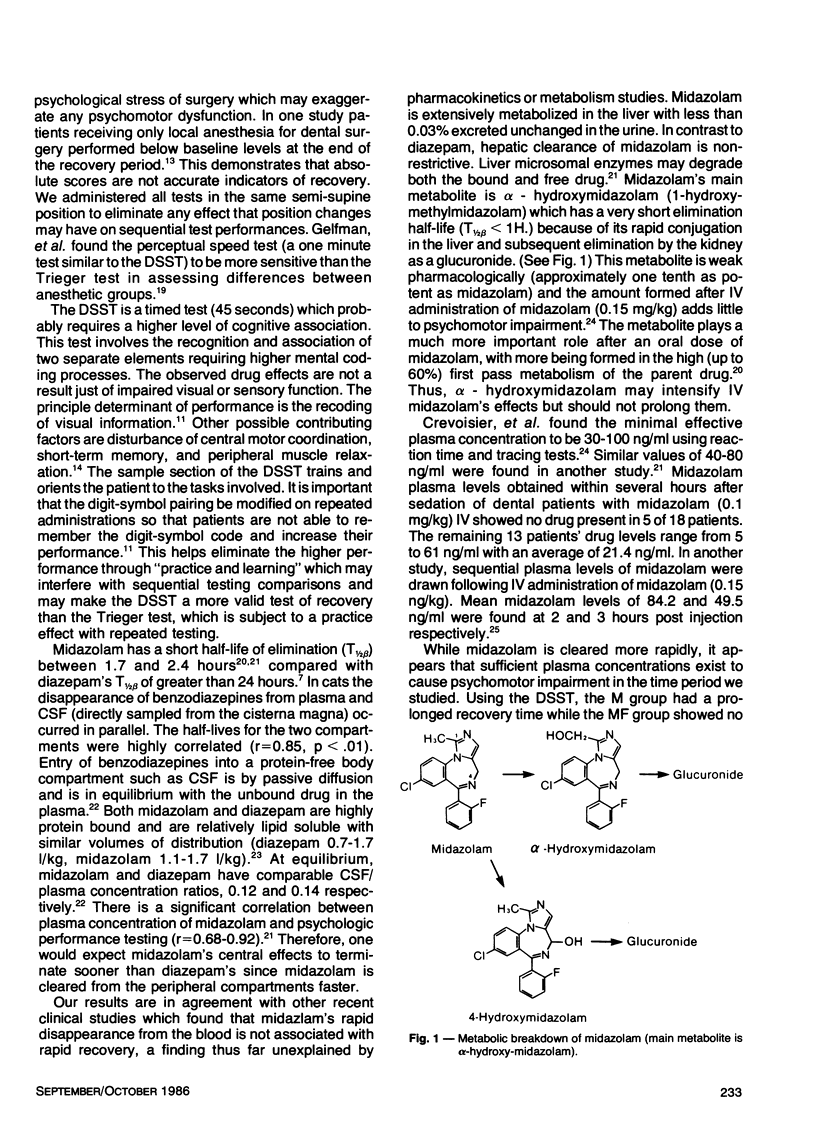
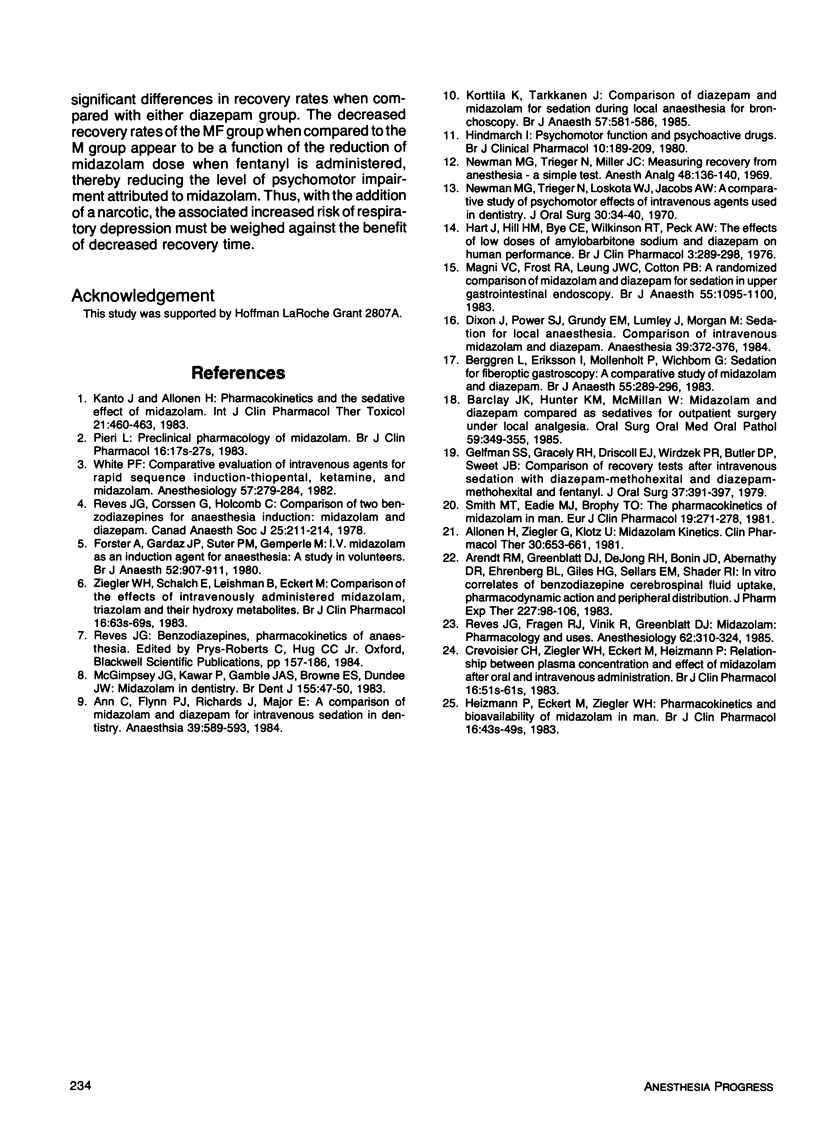
Selected References
These references are in PubMed. This may not be the complete list of references from this article.
- Allonen H., Ziegler G., Klotz U. Midazolam kinetics. Clin Pharmacol Ther. 1981 Nov;30(5):653–661. doi: 10.1038/clpt.1981.217. [DOI] [PubMed] [Google Scholar]
- Arendt R. M., Greenblatt D. J., deJong R. H., Bonin J. D., Abernethy D. R., Ehrenberg B. L., Giles H. G., Sellers E. M., Shader R. I. In vitro correlates of benzodiazepine cerebrospinal fluid uptake, pharmacodynamic action and peripheral distribution. J Pharmacol Exp Ther. 1983 Oct;227(1):98–106. [PubMed] [Google Scholar]
- Aun C., Flynn P. J., Richards J., Major E. A comparison of midazolam and diazepam for intravenous sedation in dentistry. Anaesthesia. 1984 Jun;39(6):589–593. doi: 10.1111/j.1365-2044.1984.tb07370.x. [DOI] [PubMed] [Google Scholar]
- Barclay J. K., Hunter K. M., McMillan W. Midazolam and diazepam compared as sedatives for outpatient surgery under local analgesia. Oral Surg Oral Med Oral Pathol. 1985 Apr;59(4):349–355. doi: 10.1016/0030-4220(85)90056-8. [DOI] [PubMed] [Google Scholar]
- Berggren L., Eriksson I., Mollenholt P., Wickbom G. Sedation for fibreoptic gastroscopy: a comparative study of midazolam and diazepam. Br J Anaesth. 1983 Apr;55(4):289–296. doi: 10.1093/bja/55.4.289. [DOI] [PubMed] [Google Scholar]
- Crevoisier C., Ziegler W. H., Eckert M., Heizmann P. Relationship between plasma concentration and effect of midazolam after oral and intravenous administration. Br J Clin Pharmacol. 1983;16 (Suppl 1):51S–61S. doi: 10.1111/j.1365-2125.1983.tb02271.x. [DOI] [PMC free article] [PubMed] [Google Scholar]
- Dixon J., Power S. J., Grundy E. M., Lumley J., Morgan M. Sedation for local anaesthesia. Comparison of intravenous midazolam and diazepam. Anaesthesia. 1984 Apr;39(4):372–376. doi: 10.1111/j.1365-2044.1984.tb07281.x. [DOI] [PubMed] [Google Scholar]
- Forster A., Gardaz J. P., Suter P. M., Gemperle M. I.V. midazolam as an induction agent for anaesthesia: a study in volunteers. Br J Anaesth. 1980 Sep;52(9):907–911. doi: 10.1093/bja/52.9.907. [DOI] [PubMed] [Google Scholar]
- Gelfman S. S., Gracely R. H., Driscoll E. J., Wirdzek P. R., Butler D. P., Sweet J. B. Comparison of recovery tests after intravenous sedation with diazepam-methohexital and diazepam-methohexital and fentanyl. J Oral Surg. 1979 Jun;37(6):391–397. [PubMed] [Google Scholar]
- Hart J., Hill H. M., Bye C. E., Wilkinson R. T., Peck A. W. The effects of low doses of amylobarbitone sodium and diazepam on human performance. Br J Clin Pharmacol. 1976 Apr;3(2):289–298. doi: 10.1111/j.1365-2125.1976.tb00606.x. [DOI] [PMC free article] [PubMed] [Google Scholar]
- Heizmann P., Eckert M., Ziegler W. H. Pharmacokinetics and bioavailability of midazolam in man. Br J Clin Pharmacol. 1983;16 (Suppl 1):43S–49S. doi: 10.1111/j.1365-2125.1983.tb02270.x. [DOI] [PMC free article] [PubMed] [Google Scholar]
- Hindmarch I. Psychomotor function and psychoactive drugs. Br J Clin Pharmacol. 1980 Sep;10(3):189–209. doi: 10.1111/j.1365-2125.1980.tb01745.x. [DOI] [PMC free article] [PubMed] [Google Scholar]
- Kanto J., Allonen H. Pharmacokinetics and the sedative effect of midazolam. Int J Clin Pharmacol Ther Toxicol. 1983 Sep;21(9):460–463. [PubMed] [Google Scholar]
- Korttila K., Tarkkanen J. Comparison of diazepam and midazolam for sedation during local anaesthesia for bronchoscopy. Br J Anaesth. 1985 Jun;57(6):581–586. doi: 10.1093/bja/57.6.581. [DOI] [PubMed] [Google Scholar]
- Magni V. C., Frost R. A., Leung J. W., Cotton P. B. A randomized comparison of midazolam and diazepam for sedation in upper gastrointestinal endoscopy. Br J Anaesth. 1983 Nov;55(11):1095–1101. doi: 10.1093/bja/55.11.1095. [DOI] [PubMed] [Google Scholar]
- McGimpsey J. G., Kawar P., Gamble J. A., Browne E. S., Dundee J. W. Midazolam in dentistry. Br Dent J. 1983 Jul 23;155(2):47–50. doi: 10.1038/sj.bdj.4805120. [DOI] [PubMed] [Google Scholar]
- Newman M. G., Trieger N., Loskota W. J., Jacobs A. W. A comparative study of psychomotor effects of intravenous agents used in dentistry. Oral Surg Oral Med Oral Pathol. 1970 Jul;30(1):34–40. doi: 10.1016/0030-4220(70)90007-1. [DOI] [PubMed] [Google Scholar]
- Newman M. G., Trieger N., Miller J. C. Measuring recovery from anesthesia--a simple test. Anesth Analg. 1969 Jan-Feb;48(1):136–140. [PubMed] [Google Scholar]
- Pieri L. Preclinical pharmacology of midazolam. Br J Clin Pharmacol. 1983;16 (Suppl 1):17S–27S. doi: 10.1111/j.1365-2125.1983.tb02267.x. [DOI] [PMC free article] [PubMed] [Google Scholar]
- Reves J. G., Corssen G., Holcomb C. Comparison of two benzodiazepines for anaesthesia induction: midazolam and diazepam. Can Anaesth Soc J. 1978 May;25(3):211–214. doi: 10.1007/BF03004881. [DOI] [PubMed] [Google Scholar]
- Reves J. G., Fragen R. J., Vinik H. R., Greenblatt D. J. Midazolam: pharmacology and uses. Anesthesiology. 1985 Mar;62(3):310–324. [PubMed] [Google Scholar]
- Smith M. T., Eadie M. J., Brophy T. O. The pharmacokinetics of midazolam in man. Eur J Clin Pharmacol. 1981 Mar;19(4):271–278. doi: 10.1007/BF00562804. [DOI] [PubMed] [Google Scholar]
- White P. F. Comparative evaluation of intravenous agents for rapid sequence induction--thiopental, ketamine, and midazolam. Anesthesiology. 1982 Oct;57(4):279–284. doi: 10.1097/00000542-198210000-00005. [DOI] [PubMed] [Google Scholar]
- Ziegler W. H., Schalch E., Leishman B., Eckert M. Comparison of the effects of intravenously administered midazolam, triazolam and their hydroxy metabolites. Br J Clin Pharmacol. 1983;16 (Suppl 1):63S–69S. doi: 10.1111/j.1365-2125.1983.tb02272.x. [DOI] [PMC free article] [PubMed] [Google Scholar]


